Bitcoin Sluggish Demand Blamed for $10K Plunge In a Week
Bitcoin's price plunged over $10K within a week, driven by reduced market demand, ETF outflows, and expectations for Fed rate cuts, signaling potential future corrections if demand doesn't recover.
After hitting a new all-time high just last Thursday, Bitcoin’s price has plummeted by over $10,000 in a week.
A new analysis suggests the sharp correction stems from a key factor: a slowdown in demand across the Bitcoin market.
Bitcoin Demand Slowing Down
Julio Moreno, head of research at on-chain platform CryptoQuant, shared this view in an X post on Wednesday. He stated, “Bitcoin’s overall demand growth slowdown, including purchases from ETFs and Strategy, is behind the current price pause/correction.”
Bitcoin’s price had briefly bottomed out on August 1st, when concerns about a recession flared up after a weak US non-farm payrolls report. That same day, US spot Bitcoin ETFs saw $812 million in net outflows, according to Soso Value data.
 Daily Net Inflows/Outflows of U.S. Spot Bitcoin ETFs. Source: SoSo Value
Daily Net Inflows/Outflows of U.S. Spot Bitcoin ETFs. Source: SoSo Value
However, from August 6, when the price rally began, the ETFs recorded seven consecutive days of net inflows. This trend reversed last Thursday with the July Producer Price Index’s release, returning to net outflows. The outflow volume wasn’t very large, yet Bitcoin’s price dropped sharply in comparison.
Moreno explained that on-chain demand metrics mirror this exact pattern. He argues that this correction isn’t due to the sudden actions of a single entity like an ETF or MicroStrategy, but rather a widespread decline in demand among most market participants.
For example, CryptoQuant’s Apparent Demand metric showed a reading of 147.3703K on August 1, a similar price level. However, on August 20, the same metric had nearly halved to 64.787K.
 Bitcoin: Apparent Demand & Bitcoin: Demand Growth. Source: CryptoQuant
Bitcoin: Apparent Demand & Bitcoin: Demand Growth. Source: CryptoQuant
While Bitcoin’s price surged and then returned to its starting point over the past 15 days, market demand essentially dropped by half. This suggests that if market sentiment doesn’t recover, Bitcoin could face further corrections.
The market likely needs a macroeconomic catalyst to boost overall demand, such as renewed expectations of a Fed rate cut. According to CME’s FedWatch data, market participants anticipate two rate cuts this year, with an 86% probability of a 25 basis point cut at the September FOMC meeting.
For comparison, last Thursday, when Bitcoin’s price approached $124,000, the market priced in three rate cuts this year and a 98% chance of a cut in September.
Disclaimer: The content of this article solely reflects the author's opinion and does not represent the platform in any capacity. This article is not intended to serve as a reference for making investment decisions.
You may also like
$8.8 billion outflow countdown: MSTR is becoming the abandoned child of global index funds
The final result will be revealed on January 15, 2026, and the market has already started to vote with its feet.

Deconstructing DAT: Beyond mNAV, How to Identify "Real vs. Fake HODLing"?
There is only one iron rule for investing in DAT: ignore premium bubbles and only invest in those with a genuine flywheel of continuously increasing "crypto per share."

Empowered by AI Avatars, How Does TwinX Create Immersive Interaction and a Value Closed Loop?
1. **Challenges in the Creator Economy**: Web2 content platforms suffer from issues such as opaque algorithms, non-transparent distribution, unclear commission rates, and high costs for fan migration, making it difficult for creators to control their own data and earnings. 2. **Integration of AI and Web3**: The development of AI technology, especially AI Avatar technology, combined with Web3's exploration of the creator economy, offers new solutions aimed at breaking the control of centralized platforms and reconstructing content production and value distribution. 3. **Positioning of the TwinX Platform**: TwinX is an AI-driven Web3 short video social platform that aims to reconstruct content, interaction, and value distribution through AI avatars, immersive interactions, and a decentralized value system, enabling creators to own their data and income. 4. **Core Features of TwinX**: These include AI avatar technology, which allows creators to generate a learnable, configurable, and sustainably operable "second persona", as well as a closed-loop commercialization pathway that integrates content creation, interaction, and monetization. 5. **Web3 Characteristics**: TwinX embodies the assetization and co-governance features of Web3. It utilizes blockchain to confirm and record interactive behaviors, turning user activities into traceable assets, and enables participants to engage in platform governance through tokens, thus integrating the creator economy with community governance.

Aster CEO explains in detail the vision of Aster privacy L1 chain, reshaping the decentralized trading experience
Aster is set to launch a privacy-focused Layer 1 (L1) public chain, along with detailed plans for token empowerment, global market expansion, and liquidity strategies.

